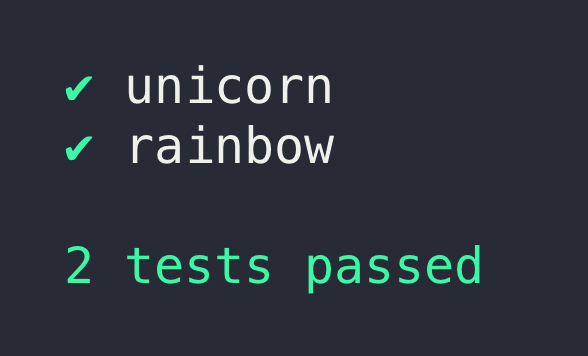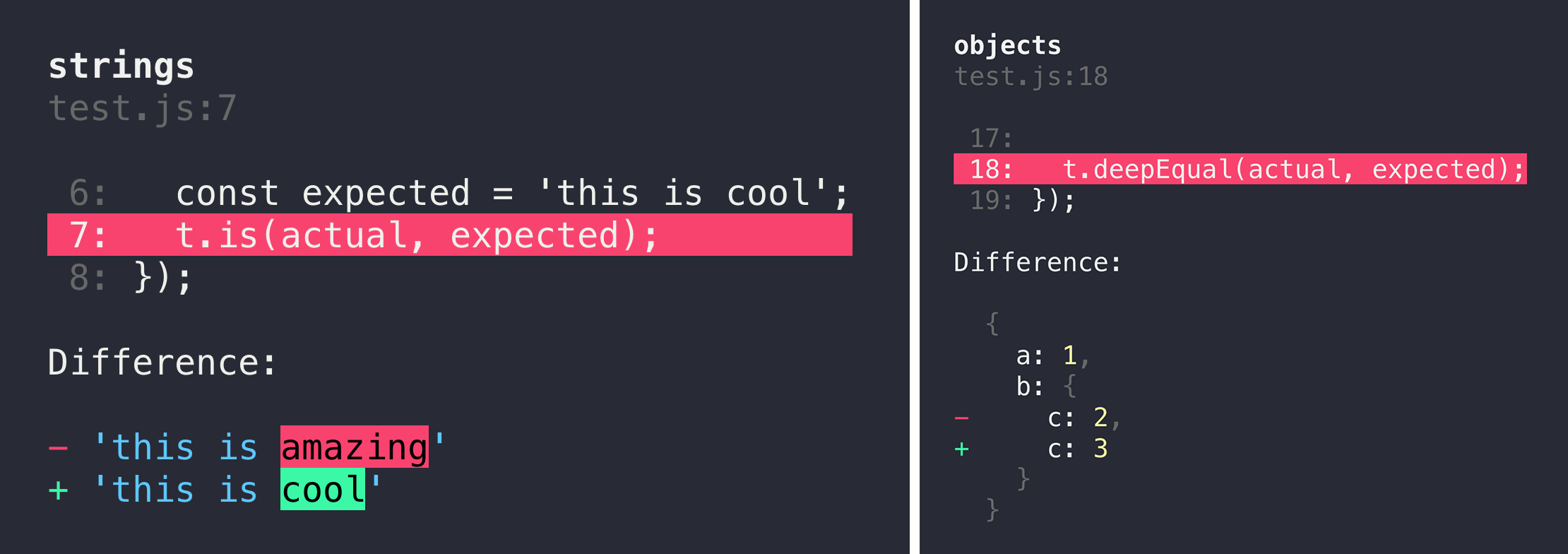AVA is a test runner for Node.js with a concise API, detailed error output, embrace of new language features and process isolation that lets you develop with confidence 🚀
Follow the AVA Twitter account for updates.
Read our contributing guide if you're looking to contribute (issues / PRs / etc).
Translations: Español, Français, Italiano, 日本語, 한국어, Português, Русский, 简体中文
- Minimal and fast
- Simple test syntax
- Runs tests concurrently
- Enforces writing atomic tests
- No implicit globals
- Includes TypeScript definitions
- Magic assert
- Isolated environment for each test file
- Promise support
- Async function support
- Observable support
- Enhanced assertion messages
- Automatic parallel test runs in CI
- TAP reporter
To install and set up AVA, run:
npm init avaYour package.json will then look like this (exact version notwithstanding):
{
"name": "awesome-package",
"scripts": {
"test": "ava"
},
"devDependencies": {
"ava": "^1.0.0"
}
}Or if you prefer using Yarn:
yarn add ava --devAlternatively you can install ava manually:
npm install --save-dev avaDon't forget to configure the test script in your package.json as per above.
Create a file named test.js in the project root directory:
import test from 'ava';
test('foo', t => {
t.pass();
});
test('bar', async t => {
const bar = Promise.resolve('bar');
t.is(await bar, 'bar');
});npm testOr with npx:
npx avaRun with the --watch flag to enable AVA's watch mode:
npx ava --watchAVA supports the latest release of any major version that is supported by Node.js itself. Read more in our support statement.
AVA adds code excerpts and clean diffs for actual and expected values. If values in the assertion are objects or arrays, only a diff is displayed, to remove the noise and focus on the problem. The diff is syntax-highlighted too! If you are comparing strings, both single and multi line, AVA displays a different kind of output, highlighting the added or missing characters.
AVA automatically removes unrelated lines in stack traces, allowing you to find the source of an error much faster, as seen above.
AVA automatically detects whether your CI environment supports parallel builds. Each build will run a subset of all test files, while still making sure all tests get executed. See the ci-parallel-vars package for a list of supported CI environments.
Please see the files in the docs directory:
- Writing tests
- Execution context
- Assertions
- Snapshot testing
- Command line (CLI)
- Configuration
- Test timeouts
We have a growing list of common pitfalls you may experience while using AVA. If you encounter any issues you think are common, comment in this issue.
- Test setup
- TypeScript
- Shared workers
- Watch mode
- When to use
t.plan() - Passing arguments to your test files
- Splitting tests in CI
- Code coverage
- Endpoint testing
- Browser testing
- Testing Vue.js components
- Debugging tests with Chrome DevTools
- Debugging tests with VSCode
- Debugging tests with WebStorm
- Isolated MongoDB integration tests
- Testing web apps using Puppeteer
- Testing web apps using Selenium WebDriverJS
Mocha requires you to use implicit globals like describe and it with the default interface (which most people use). It's not very opinionated and executes tests serially without process isolation, making it slow.
Tape and tap are pretty good. AVA is highly inspired by their syntax. They too execute tests serially. Their default TAP output isn't very user-friendly though so you always end up using an external tap reporter.
In contrast AVA is highly opinionated and runs tests concurrently, with a separate process for each test file. Its default reporter is easy on the eyes and yet AVA still supports TAP output through a CLI flag.
AVA, not Ava or ava. Pronounced /ˈeɪvə/: Ay (face, made) V (vie, have) A (comma, ago)
It's the Andromeda galaxy.
Concurrency is not parallelism. It enables parallelism.
- eslint-plugin-ava — Lint rules for AVA tests
- @ava/typescript — Test TypeScript projects
- @ava/cooperate — Low-level primitives to enable cooperation between test files
- @ava/get-port — Reserve a port while testing
 |
 |
|---|---|
| Mark Wubben | Sindre Sorhus |



